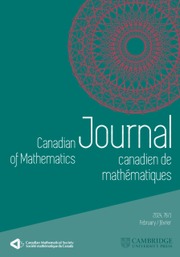No CrossRef data available.
Article contents
On a convergence of positive continuous additive functionals in terms of the smooth measures
Published online by Cambridge University Press: 16 May 2025
Abstract
A compactness of the Revuz map is established in the sense that the locally uniform convergence of a sequence of positive continuous additive functionals (PCAFs) is derived in terms of their smooth measures. To this end, we first introduce a metric on the space of measures of finite energy integrals and show some structures of the metric. Then, we show the compactness and give some examples of PCAFs that the convergence holds in terms of the associated smooth measures.
MSC classification
Primary:
31C25: Dirichlet spaces
Information
- Type
- Article
- Information
- Copyright
- © The Author(s), 2025. Published by Cambridge University Press on behalf of Canadian Mathematical Society
Footnotes
This work was supported by JSPS KAKENHI Grant Numbers JP19H00643 (T.U.), JP22K03340 (M.T., T.U.), JP22K03427 (Y.N.).
References
Andres, S. and Kajino, N.,
Continuity and estimates of the Liouville heat kernel with applications to spectral dimensions
. Probab. Theory Rel. Fields 166(2016), 713–752.10.1007/s00440-015-0670-4CrossRefGoogle Scholar
Chen, Z.-Q. and Fukushima, M., Symmetric Markov processes, time change, and boundary theory. Princeton University Press, Princeton, 2011.Google Scholar
Chen, Z.-Q., Tomisaki, M., and Uemura, T., On convergences of perturbed Dirichlet forms, in preparation, 2025.Google Scholar
Fukushima, M.,
From one dimensional diffusions to symmetric Markov processes
. Stoch. Process. Appl. 120(2010), 590–604. (Special issue A tribute to Kiyosi Itô)10.1016/j.spa.2010.01.010CrossRefGoogle Scholar
Fukushima, M.,
On general boundary conditions for one-dimensional diffusions with symmetry
. J. Math. Soc. Japan 66(2014), 289–316.10.2969/jmsj/06610289CrossRefGoogle Scholar
Fukushima, M. and Oshima, Y.,
On the skew product of symmetric diffusion processes
. Forum Math. 1(1989), 103–142.10.1515/form.1989.1.103CrossRefGoogle Scholar
Fukushima, M., Oshima, Y., and Takeda, M., Dirichlet forms and Markov processes. 2nd ed., Walter de Gruyter, Berlin, 2011.Google Scholar
Garban, C., Rhodes, R., and Vargas, V.,
Liouville Brownian motion
. Ann. Probab. 44(2016), 3076–3110.10.1214/15-AOP1042CrossRefGoogle Scholar
Itô, K. and McKean, H. P., Diffusion processes and their sample paths. Springer-Verlag, New York, 1974.Google Scholar
Landkof, N. S., Foundations of modern potential theory. Springer, New York, 1972.10.1007/978-3-642-65183-0CrossRefGoogle Scholar
Okura, H.,
A new approach to the skew product of symmetric Markov processes
. Mem. Fac. Eng. Design Kyoto Inst. Technol. 46(1998), 1–12.Google Scholar
Ooi, T., Convergence of processes time-changed by Gaussian multiplicative chaos. To appear in Potential Analysis.Google Scholar


